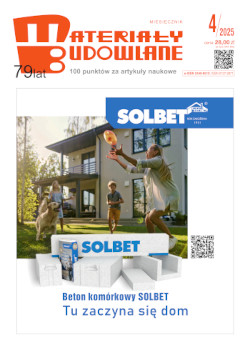dr inż. Zofia Szweda, Politechnika Śląska; Wydział Budownictwa
ORCID: 0000-0001-5543-7494
Adres do korespondencji: Ten adres pocztowy jest chroniony przed spamowaniem. Aby go zobaczyć, konieczne jest włączenie w przeglądarce obsługi JavaScript.
DOI: 10.15199/33.2019.07.05
Oryginalny artykuł naukowy (Original research paper)
Celem pracy była analiza wyznaczonych wartości współczynnika dyfuzji imigracji chlorków z betonu pobranego bezpośrednio z prefabrykowanych płyt strunobetonowych typu HC-500. Do analizy wykorzystano wartości współczynników dyfuzji imigracji wyznaczone metodami normowymi oraz wg termodynamicznego modelu migracji. Rozważane współczynniki dyfuzji i migracji bardzo istotnie różnią się od siebie. Porównano wartości błędu średniokwadratowego między wartościami stężenia jonów chlorkowych wyznaczonymi na podstawie rozwiązania równania dyfuzji z zastosowaniem współczynników dyfuzji określonych różnymi metodami a wartościami pomierzonymi w badaniach dyfuzyjnych.
Słowa kluczowe: współczynnik dyfuzji; migracja chlorków; prefabrykowane płyty strunobetonowe.
Analysis of diffusion andmigration coefficient values in prefabricated floorHC-500 slabs
Abstract. The aim of the work was analysis of the determained diffusion coefficient values and chlorides migration in concrete which was taken directly from prefabricated prestressed HC-500 slabs.Diffusion coefficient andmigration values used in the analysis were determined in accordance with the norm and thermodynamic migrationmodel. Said diffusion coefficient andmigration coefficient are significantly different. Values of mean square error between values of chloride ions concentration and values determined by the diffusion research were compared. Chloride ions concentrations were determined based on the solution of diffusion equation with the use of diffusion coefficients determined with various methods.
Keywords: diffusion coefficient; chlorides migration; prefabricated prestressed slabs.
Literatura
[1] ASTM C 1202-97. Standard test method for electrical indication of concrete’s ability to resist chloride ion penetration. American Society for Testing and Material, Philadelphia 1997.
[2] ASTMC 1556-03. Standard testmethod for determining the apparent chloride diffusion coefficient of cementitious mixtures by bulk diffusion, 2003.
[3] ASTMC 1760 Standard Test Method for Bulk Electrical Conductivity of Hardened Concrete.
[4] Czarnecki Lech, Piotr Woyciechowski. 2013. „Prediction of the reinforced concrete structure durability under the risk of carbonation and chloride aggression”. Bulletin Of The Polish Academy of Sciences Technical Sciences,Vol. 61, No. 1, DOI: 10.2478/bpasts-2013-0016.
[5] Konecný Petr, Petr Lehner, Tomasz Ponikiewski, Patrycja Miera. 2017. „Comparison of Chloride Diffusion Coefficient Evaluation Based on Electrochemical Methods”. Procedia Eng., 190, pp. 193 – 198. DOI: 10.1016/j.proeng.2017.05.326.
[6] NT BUILD 443. Concrete, hardened: Accelerated chloride penetration. Approved 1995–11.
[7] NT BUILD 492. Concrete, mortar and cement- based repair materials, chloride migration coefficient fromnon-steady-statemigration experiments. Nordtest Method 492; 1999.
[8] Szweda Zofia. 2018, „The analysis of the protective features of the concrete used in prefabricated prestressed concrete slabs (type HC) for the chlorides penetration”. MATEC Web of Conf., vol. 163 2261- 236X. DOI: 10.1051/matecconf/201816305006.
[9] Szweda Zofia. 2018. „Comparison of diffusion and migration coefficients determined fromtests on concrete in prestressed floor slabs HC-500”. 2019. IOP Conference Series Materials Science and Engineering 471: 052034. DOI: 10.1088/1757- 899X/471/5/0520341757-8981.
Przyjęto do druku: 30.05.2019 r.
Materiały Budowlane 7/2019, str. 34-35 (spis treści >>)



























